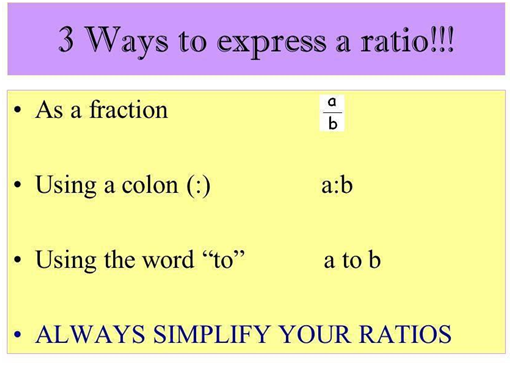LEARN MATH STEP BY STEP THROUGH VERY EASY PROCESS
CLASS-6
RATIO - WAY TO EXPRESS RATIO
WAY TO EXPRESS RATIO -
Ratios can be expressed in several ways, depending on the context and the preference of the person or organization using them. Here are some common ways to express ratios:
- Colon (a:b):- This is the most common way to express ratios. For example, the ratio of boys to girls in a class of 30 students could be written as 2:3, meaning there are 2 boys for every 3 girls.
- Fraction (a/b):- Ratios can be represented as fractions. Using the same example, the ratio of boys to girls in a class of 30 students can be expressed as 2/3.
- Percentage (%):- Ratios can also be expressed as percentages. To convert a ratio to a percentage, you multiply by 100%. For instance, if you have a ratio of 3:7, you can express it as 42.86% by dividing 3 by (3 + 7) and multiplying by 100.
- Decimal (a.b):- Ratios can be expressed as decimals. For example, a ratio of 4:5 can be expressed as 0.8 in decimal form.
- Words:- Sometimes, ratios are expressed in words for clarity. For instance, if the ratio of men to women in a company is 1:4, it can be stated as "there is one man for every four women."
- Proportions:- In some cases, ratios are used to create proportions. For example, if you know that 2 out of 5 people prefer apples to oranges, you can set up the proportion 2/5 = x/100 to find the percentage of people who prefer apples.
- Graphical Representation:- Ratios can also be represented graphically using diagrams like bar charts or pie charts to show the relative proportions of different parts.
- Table:- Ratios can be presented in tabular form, particularly when comparing multiple categories or groups. This is common in statistics and data analysis.

Ratios can be expressed in several ways, depending on the context and the preference of the person using them. Here are some common ways to express ratios:
- Colon Notation:- This is the most straightforward way to express a ratio, using a colon (":") between the two numbers. For example, the ratio of boys to girls in a classroom with 20 boys and 30 girls can be written as 20:30.
- Fractional Form:- Ratios can also be expressed as fractions. Using the same example, the ratio of boys to girls can be written as 20/30, which can be simplified to 2/3.
- Percentage Form:- Ratios can be converted to percentages by multiplying by 100. For example, if you have a ratio of 3:5, you can express it as 60% by dividing 3 by 5 and then multiplying by 100.
- Decimal Form:- Ratios can be converted to decimals by dividing one number by the other. For example, a ratio of 2:7 can be expressed as approximately 0.2857 when you divide 2 by 7.
- Words:- Sometimes, ratios are expressed in words for clarity. For example, if you have a ratio of 1:4, you can say "one for every four."
- Proportions:- Ratios are often used in proportion statements. For example, if you have a proportionality statement like "x is to y as a is to b," you can express the ratio as x:y = a:b.
- Scale Factor:- In some situations, ratios are used to describe the scale between two objects. For instance, if a map has a scale of 1 inch to 10 miles, you can express the ratio as 1:10.
- Cross Multiplication:- When solving problems involving ratios, you can use cross multiplication to find missing values. For example, in the ratio a:b = c:d, you can cross multiply to get ad = bc.
- Graphical Representation:- In data visualization, you can use bar charts or pie charts to represent ratios visually, which can make it easier to understand the relationship between quantities.
The choice of how to express a ratio depends on the specific problem or context you are dealing with. Each form has its advantages, and the choice may be influenced by the need for simplicity, clarity, or compatibility with other calculations or comparisons.